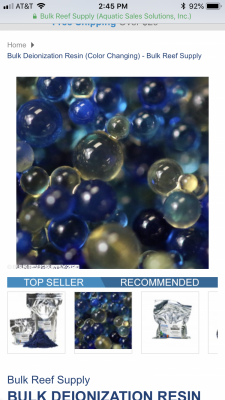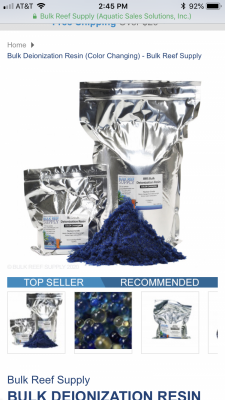The resin they originally sent began changing color after just a few uses. The resin I got to replace it didn't have time to change color because I got the aquamedic unit shortly after.
Navigation
Install the app
How to install the app on iOS
Follow along with the video below to see how to install our site as a web app on your home screen.
Note: This feature may not be available in some browsers.
More options
You are using an out of date browser. It may not display this or other websites correctly.
You should upgrade or use an alternative browser.
You should upgrade or use an alternative browser.
The Basics of an RODI Filter
- Thread starter Reef-junky
- Start date
- Tagged users None
- Joined
- Dec 5, 2017
- Messages
- 2,888
- Reaction score
- 4,377
The first one didn't have di and produced 5 tds for 3 years.
This is why you didn’t have 0 TDS. Even a very good RO won’t get you to 0 and what you have is very cheap.
- Joined
- Dec 5, 2017
- Messages
- 2,888
- Reaction score
- 4,377
The resin they originally sent began changing color after just a few uses. The resin I got to replace it didn't have time to change color because I got the aquamedic unit shortly after.
This means something is wrong. Are you on well water? Do they use Cl gas to treat the water? How was it packaged when you got it?
My guess is water treatment or CO2.
Last edited:
This is why you didn’t have 0 TDS. Even a very good RO won’t get you to 0.
I knew that, I actually thought that it did an excellent job for 3 years. It was exposed to a high temperature and it damaged the membrane. I was surprised to see such a bad performance of the 5 stage unit.
This means something is wrong. Are you on well water? Do they use Cl gas to treat the water? How was it packaged when you got it?
I am on city water and they use chlorine, not chloramine.
The unit arrived assembled, I just had to open the containers and place the filters and membrane inside. The DI resine already came inside the container.
- Joined
- Dec 5, 2017
- Messages
- 2,888
- Reaction score
- 4,377
I am on city water and they use chlorine, not chloramine.
The unit arrived assembled, I just had to open the containers and place the filters and membrane inside. The DI resine already came inside the container.
It could be the way they stored the resin at the factory. Di should not be consumed that fast. What was the TDS after the RO?
You are probably right.
After the RO it was around 23 tds. After the original resin it was 33 tds. With the new resin it went down to 11.
After the RO it was around 23 tds. After the original resin it was 33 tds. With the new resin it went down to 11.
- Joined
- Dec 5, 2017
- Messages
- 2,888
- Reaction score
- 4,377
You are probably right.
After the RO it was around 23 tds. After the original resin it was 33 tds. With the new resin it went down to 11.
Did you get the resin from the same place? Something was definitely wrong with it if the TDS went up.
- Joined
- Oct 3, 2019
- Messages
- 768
- Reaction score
- 1,050
I recently purchased a Liquagen 5 stage RODI unit. I’ve had a few issues that their customer service team has handled, but I’m having an issue with my TDS. The first time I used it, I followed the manufacturer recommendation to flush for 30 minutes before use and was able to get 0 TDS water. I’m now running it to fill my 32 gal BRUTE for the second time, and I flushed the membrane as recommended, and my TDS won’t drop any lower than 15. My incoming TDS is 45. Any idea why it has dropped in performance so much after a single use?
- Joined
- Dec 5, 2017
- Messages
- 2,888
- Reaction score
- 4,377
I recently purchased a Liquagen 5 stage RODI unit. I’ve had a few issues that their customer service team has handled, but I’m having an issue with my TDS. The first time I used it, I followed the manufacturer recommendation to flush for 30 minutes before use and was able to get 0 TDS water. I’m now running it to fill my 32 gal BRUTE for the second time, and I flushed the membrane as recommended, and my TDS won’t drop any lower than 15. My incoming TDS is 45. Any idea why it has dropped in performance so much after a single use?
45 going into your DI seems high. What’s the RO rated for (rejection rate)?
Last edited:
- Joined
- Oct 3, 2019
- Messages
- 768
- Reaction score
- 1,050
I’m not sure what the rejection rate is, but the incoming TDS is measured before the water enters the first chamber. The output TDS is measured when the flush valve is closed and measured the water as it’s dripping into my reservoir.45 going into your DI seems high. What’s the RO rated for (rejection rate)?
- Joined
- Dec 5, 2017
- Messages
- 2,888
- Reaction score
- 4,377
I’m not sure what the rejection rate is, but the incoming TDS is measured before the water enters the first chamber. The output TDS is measured when the flush valve is closed and measured the water as it’s dripping into my reservoir.
Not sure if something is hooked up wrong or maybe the pressure is to high with the booster pump. Maybe someone from spectrapure can help?
- Joined
- Oct 3, 2019
- Messages
- 768
- Reaction score
- 1,050
It’s not a spectrapure unit. What can too much pressure affect? I’m thinking that may actually be the culprit.Not sure if something is hooked up wrong or maybe the pressure is to high with the booster pump. Maybe someone from spectrapure can help?
- Joined
- Dec 5, 2017
- Messages
- 2,888
- Reaction score
- 4,377
It’s not a spectrapure unit. What can too much pressure affect? I’m thinking that may actually be the culprit.
It can foul the membrane if it’s high enough.
- Joined
- Dec 5, 2017
- Messages
- 2,888
- Reaction score
- 4,377
It’s not a spectrapure unit. What can too much pressure affect? I’m thinking that may actually be the culprit.
a lot of times BRS or spectrapure will help even if it’s not there product. They both hang out here I believe and might have some ideas. Maybe a mod could hook us up with one of them.
Last edited:
- Joined
- Dec 5, 2017
- Messages
- 2,888
- Reaction score
- 4,377
I PMed them. Maybe they will lend a hand.
- Joined
- Oct 3, 2019
- Messages
- 768
- Reaction score
- 1,050
Thank you 
I'm looking to get an RO system. The things I'm most concerned about are 1) getting the right system, and 2) getting it installed correctly. It seems as if most people here install them themselves, but I'm not confident me and the hubby can do it without messing it up. Who would be the best person to install one? A plumber? A water purification company like Culligan? Any recommendations on the best systems, i.e. best filtration with least waste? TYIA!An RO membrane forces molecules through a semipermeable membrane (certain substances can pass through but not others) to form a less concentrated solution then you started with. The inside of the membrane looks like so:
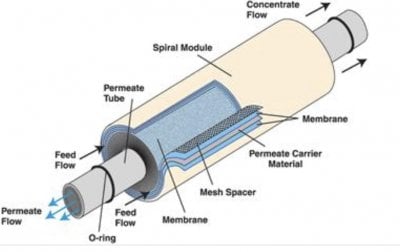
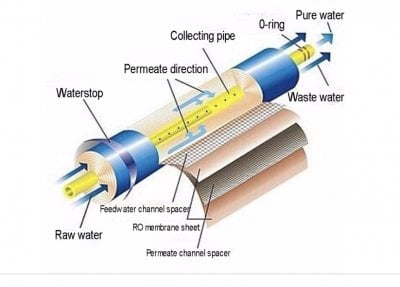
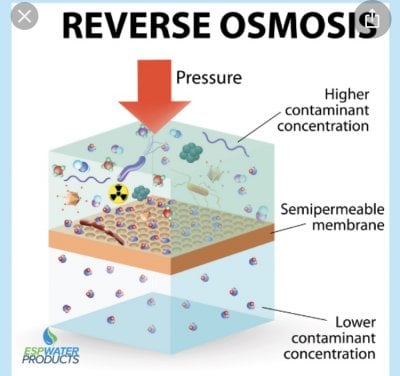
Some of the things an RO membrane can filter out are:
Lead
Copper
Arsenic
Nitrates and Nitrites
Chromium
Selenium
Fluoride
Radium
Barium
Cadmium
TDS
The filters on an RO/DI filter are called stages. The first few stages consist of prefilters that help protect the RO membrane. The first prefilter is a sediment filter. It helps remove large sediment. The next stage is a carbon filter which takes out chlorine. Some filters run two sediment and or two carbon filters. You start with a course filter and then go to a tighter one. From there we go into the RO membrane. The last stage is running the water though a DI filter this takes out the last bit of contaminates that the RO can’t get. The DI filter will take out anything with an ionic charge. You can run two DI filters to get the maximum amount of life out of your DI resin. This is a digram of an RO/DI filter.
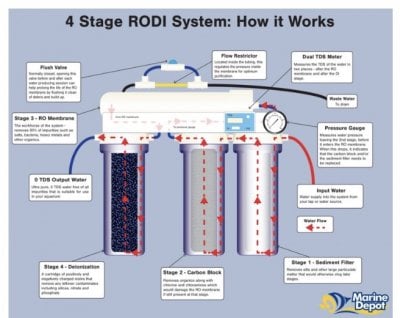
An important thing to note about RO filters is that the membrane is flushed with water the whole time you are running the filter. The water that’s used to flush the membrane is waste water. The amount of waste water your filter will produce is giving in a ratio so for example a filter might say it has a 3:1 waste water ratio. For every one gallon of good water you make you will make 3 of waste water. Let’s say we want to make 5 gallons of water for our tank that means we will end up with 15 gallons of waster water and we will end up running 20 gallons of water through the filter. There are a few things we can do to lower the amount of waste water the filter will produce. We can run two RO membranes. We could also run a booster pump to feed the filter.
There are a few things we can do to get the maximum amount of life out of our filters. We can test the water for Cl after the last carbon filter to tell us when to change the carbon out. We can also put a pressure gauge before the RO membrane when we see the pressure drop this lets us know the prefilters are starting to plug and we should change them. We can also add a flush kit to the RO membrane. This allows water to bypass the flow restrictor and flush the membrane clean. The membrane should be flushed before and after each use. You can buy an automatic flush kit which will flush the membrane for you. This will help extend the life of the RO which is the most expensive to replace. The flow restrictors job is to keep the membrane under pressure. The last thing we can do is use a TDS meter. There are two types inline and hand held. If we test the TDS after the DI resin anything higher then 0 tells you it’s time to change the resin. We can find out how well our membrane is preforming by testing the TDS of our tap water and the TDS after the RO membrane. Let’s say we have tap water that’s 200 TDS and after the RO we get 4 TDS our rejection rate is:
4/200=0.02
100(0.02)=2
100-2=98%
Once the rejection rate starts dropping by 3 or 4 % it’s time to start thinking of replacing the membrane. The membrane should tell you the expected rejection rate you will get.
There are a few things that can cause an RO/DI filter not to work well. One is if your on well water and your water has CO2 in it. If that’s the case then we need to degass the water before we run it though the DI filter. This can be done by collecting the water after the RO and putting and air stone in it. Let it sit for a day then use a small pump to run it through the DI resin or something like this can be made to degass the water as your running.

DIY CO2 Degassing Chamber for RO/DI
Well, I learned the hard way that the water coming out of my well has a high CO2 content. I burned through a pound of DI resin and only got 40 gallons out of it.... To keep this from happening again, I could either buy lots of RO/DI water or remove the CO2 from the RO water before I pass it...www.reef2reef.com
Another potential problem is if your water is treated with Chloramines. If that’s the case then you need to run an additional prefilter.

BRS Universal Carbon Block Filter - 1 Micron
Why does BRS recommend this? We spent a ton of time researching and testing to find the best carbon block available while still being reasonable when it comes to price. There are other filters that work well however do not last as long. By simply just looking down the center of the carbon block...www.bulkreefsupply.com
An RO/DI filter looks like this. You can see the 2nd RO on top of the main one and you can see the flow restrictor in the 2nd picture.
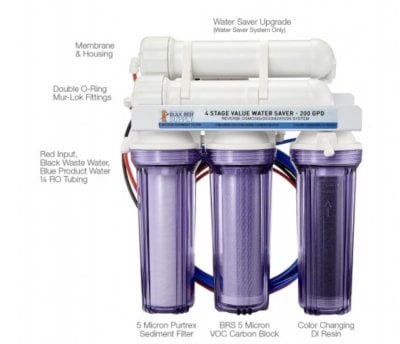
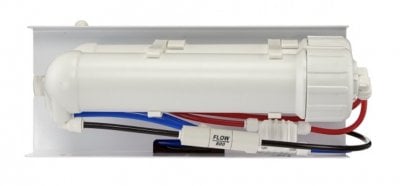
An automatic RO/DI flush kit looks like this.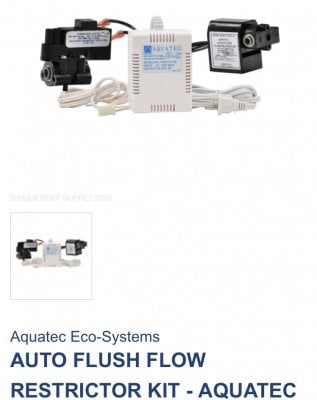
And a booster pump looks like this: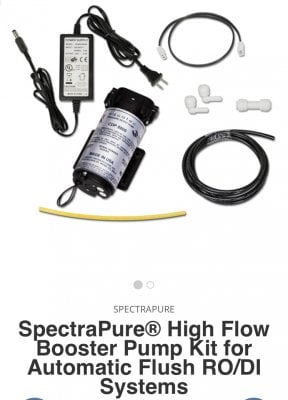
Similar threads
- Replies
- 16
- Views
- 353
- Replies
- 6
- Views
- 165
- Replies
- 1
- Views
- 160
- Replies
- 2
- Views
- 202
- Replies
- 9
- Views
- 190





